Nursing Assignment 19: Case Study Analysis and Answers
VerifiedAdded on 2021/04/24
|21
|4840
|44
Homework Assignment
AI Summary
This nursing assignment presents a comprehensive analysis of several case studies, addressing critical aspects of patient care and healthcare management. The first section prioritizes nursing tasks, emphasizing delegation, medication administration, and effective communication within a healthcare team. It highlights the importance of clinical judgment and adherence to nursing standards, particularly in emergency situations. The second section explores the composition and leadership of healthcare teams, focusing on factors determining team member involvement and the significance of the patient's role. The assignment then analyzes a case involving a patient with intellectual impairment, discussing key issues, healthcare team composition, and the roles of various professionals. Finally, it examines a patient handover scenario using the ISOBAR format, identifying areas for further questioning to ensure comprehensive patient assessment and care. The assignment underscores the importance of critical thinking, effective communication, and a patient-centered approach in nursing practice.
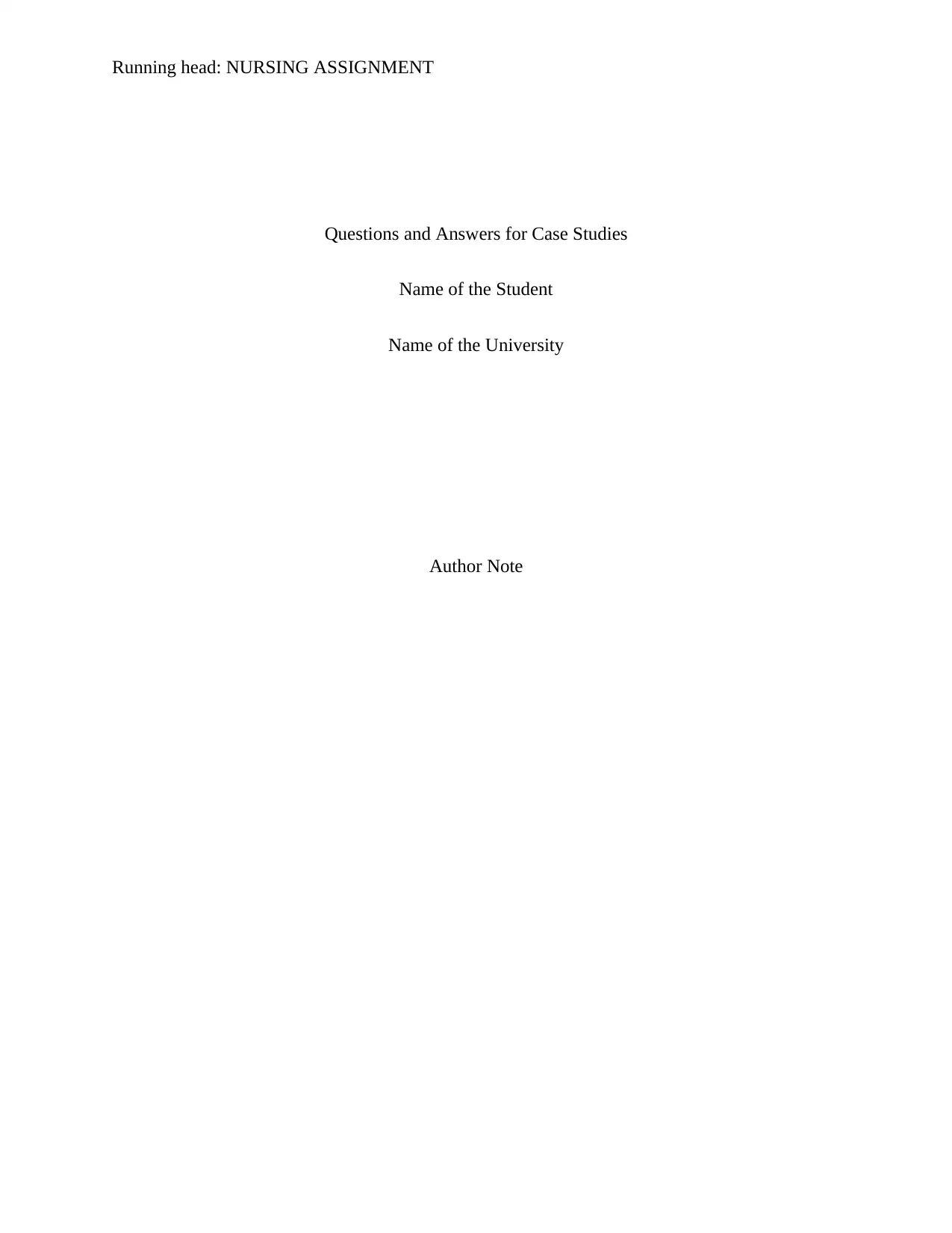
Running head: NURSING ASSIGNMENT
Questions and Answers for Case Studies
Name of the Student
Name of the University
Author Note
Questions and Answers for Case Studies
Name of the Student
Name of the University
Author Note
Paraphrase This Document
Need a fresh take? Get an instant paraphrase of this document with our AI Paraphraser
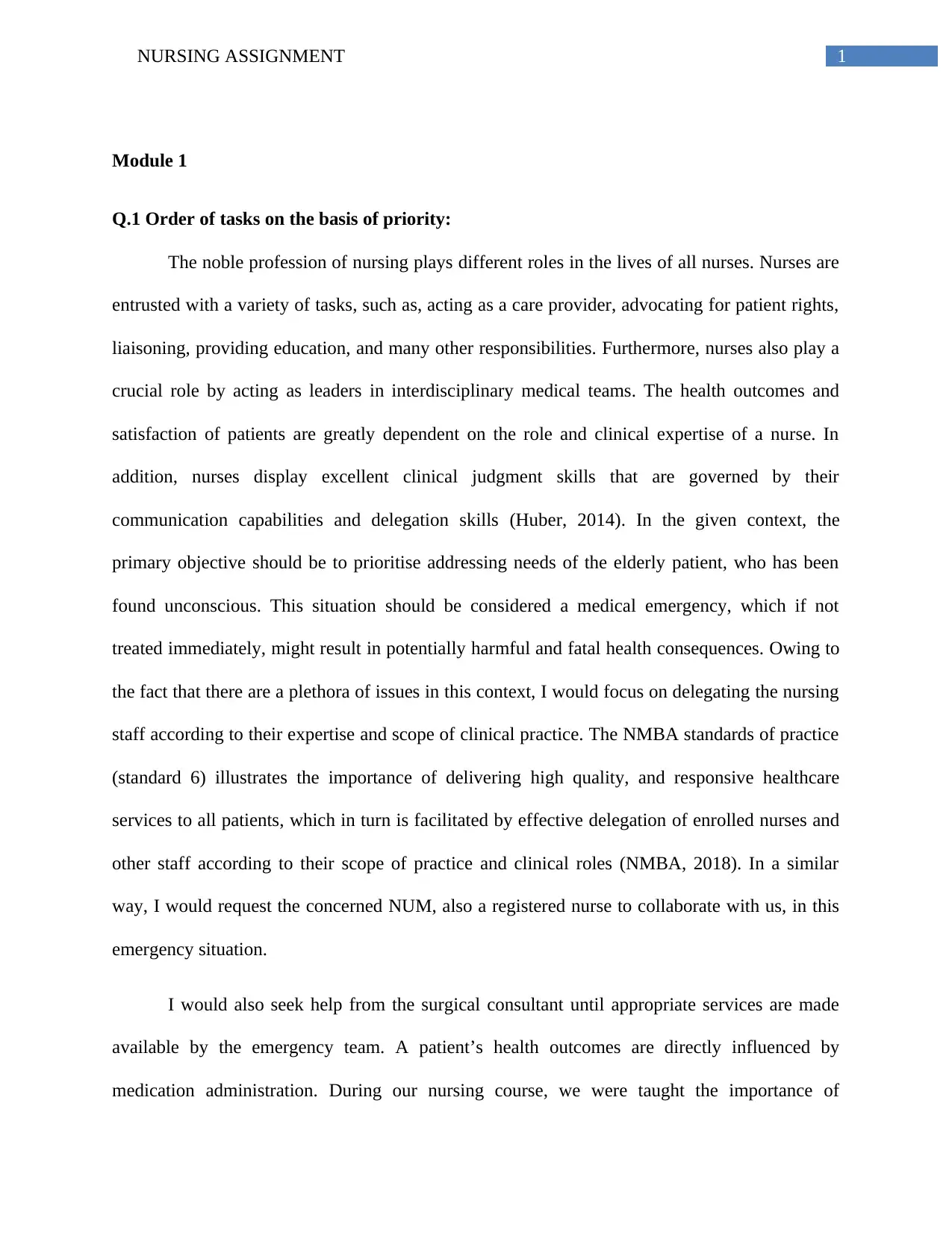
1NURSING ASSIGNMENT
Module 1
Q.1 Order of tasks on the basis of priority:
The noble profession of nursing plays different roles in the lives of all nurses. Nurses are
entrusted with a variety of tasks, such as, acting as a care provider, advocating for patient rights,
liaisoning, providing education, and many other responsibilities. Furthermore, nurses also play a
crucial role by acting as leaders in interdisciplinary medical teams. The health outcomes and
satisfaction of patients are greatly dependent on the role and clinical expertise of a nurse. In
addition, nurses display excellent clinical judgment skills that are governed by their
communication capabilities and delegation skills (Huber, 2014). In the given context, the
primary objective should be to prioritise addressing needs of the elderly patient, who has been
found unconscious. This situation should be considered a medical emergency, which if not
treated immediately, might result in potentially harmful and fatal health consequences. Owing to
the fact that there are a plethora of issues in this context, I would focus on delegating the nursing
staff according to their expertise and scope of clinical practice. The NMBA standards of practice
(standard 6) illustrates the importance of delivering high quality, and responsive healthcare
services to all patients, which in turn is facilitated by effective delegation of enrolled nurses and
other staff according to their scope of practice and clinical roles (NMBA, 2018). In a similar
way, I would request the concerned NUM, also a registered nurse to collaborate with us, in this
emergency situation.
I would also seek help from the surgical consultant until appropriate services are made
available by the emergency team. A patient’s health outcomes are directly influenced by
medication administration. During our nursing course, we were taught the importance of
Module 1
Q.1 Order of tasks on the basis of priority:
The noble profession of nursing plays different roles in the lives of all nurses. Nurses are
entrusted with a variety of tasks, such as, acting as a care provider, advocating for patient rights,
liaisoning, providing education, and many other responsibilities. Furthermore, nurses also play a
crucial role by acting as leaders in interdisciplinary medical teams. The health outcomes and
satisfaction of patients are greatly dependent on the role and clinical expertise of a nurse. In
addition, nurses display excellent clinical judgment skills that are governed by their
communication capabilities and delegation skills (Huber, 2014). In the given context, the
primary objective should be to prioritise addressing needs of the elderly patient, who has been
found unconscious. This situation should be considered a medical emergency, which if not
treated immediately, might result in potentially harmful and fatal health consequences. Owing to
the fact that there are a plethora of issues in this context, I would focus on delegating the nursing
staff according to their expertise and scope of clinical practice. The NMBA standards of practice
(standard 6) illustrates the importance of delivering high quality, and responsive healthcare
services to all patients, which in turn is facilitated by effective delegation of enrolled nurses and
other staff according to their scope of practice and clinical roles (NMBA, 2018). In a similar
way, I would request the concerned NUM, also a registered nurse to collaborate with us, in this
emergency situation.
I would also seek help from the surgical consultant until appropriate services are made
available by the emergency team. A patient’s health outcomes are directly influenced by
medication administration. During our nursing course, we were taught the importance of
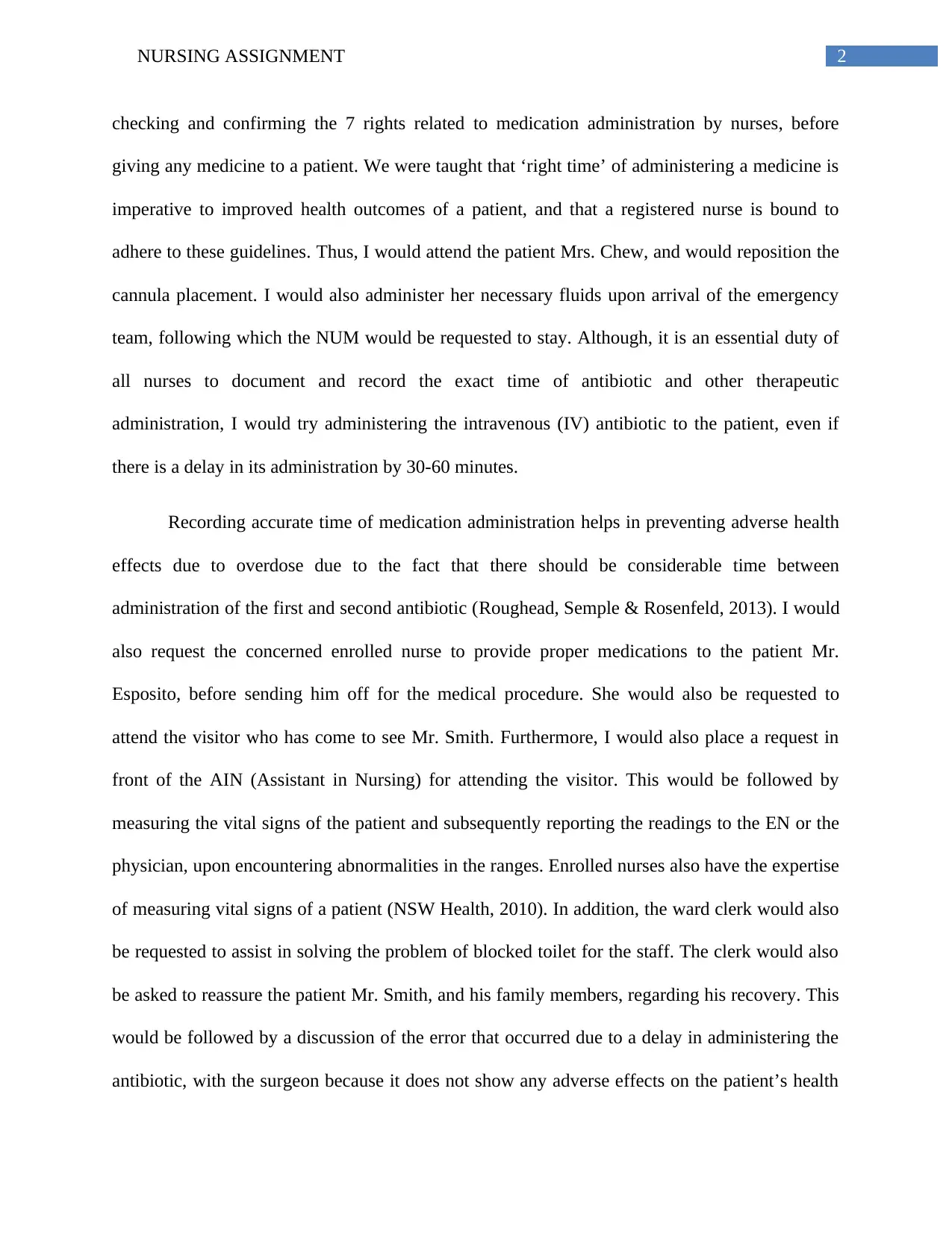
2NURSING ASSIGNMENT
checking and confirming the 7 rights related to medication administration by nurses, before
giving any medicine to a patient. We were taught that ‘right time’ of administering a medicine is
imperative to improved health outcomes of a patient, and that a registered nurse is bound to
adhere to these guidelines. Thus, I would attend the patient Mrs. Chew, and would reposition the
cannula placement. I would also administer her necessary fluids upon arrival of the emergency
team, following which the NUM would be requested to stay. Although, it is an essential duty of
all nurses to document and record the exact time of antibiotic and other therapeutic
administration, I would try administering the intravenous (IV) antibiotic to the patient, even if
there is a delay in its administration by 30-60 minutes.
Recording accurate time of medication administration helps in preventing adverse health
effects due to overdose due to the fact that there should be considerable time between
administration of the first and second antibiotic (Roughead, Semple & Rosenfeld, 2013). I would
also request the concerned enrolled nurse to provide proper medications to the patient Mr.
Esposito, before sending him off for the medical procedure. She would also be requested to
attend the visitor who has come to see Mr. Smith. Furthermore, I would also place a request in
front of the AIN (Assistant in Nursing) for attending the visitor. This would be followed by
measuring the vital signs of the patient and subsequently reporting the readings to the EN or the
physician, upon encountering abnormalities in the ranges. Enrolled nurses also have the expertise
of measuring vital signs of a patient (NSW Health, 2010). In addition, the ward clerk would also
be requested to assist in solving the problem of blocked toilet for the staff. The clerk would also
be asked to reassure the patient Mr. Smith, and his family members, regarding his recovery. This
would be followed by a discussion of the error that occurred due to a delay in administering the
antibiotic, with the surgeon because it does not show any adverse effects on the patient’s health
checking and confirming the 7 rights related to medication administration by nurses, before
giving any medicine to a patient. We were taught that ‘right time’ of administering a medicine is
imperative to improved health outcomes of a patient, and that a registered nurse is bound to
adhere to these guidelines. Thus, I would attend the patient Mrs. Chew, and would reposition the
cannula placement. I would also administer her necessary fluids upon arrival of the emergency
team, following which the NUM would be requested to stay. Although, it is an essential duty of
all nurses to document and record the exact time of antibiotic and other therapeutic
administration, I would try administering the intravenous (IV) antibiotic to the patient, even if
there is a delay in its administration by 30-60 minutes.
Recording accurate time of medication administration helps in preventing adverse health
effects due to overdose due to the fact that there should be considerable time between
administration of the first and second antibiotic (Roughead, Semple & Rosenfeld, 2013). I would
also request the concerned enrolled nurse to provide proper medications to the patient Mr.
Esposito, before sending him off for the medical procedure. She would also be requested to
attend the visitor who has come to see Mr. Smith. Furthermore, I would also place a request in
front of the AIN (Assistant in Nursing) for attending the visitor. This would be followed by
measuring the vital signs of the patient and subsequently reporting the readings to the EN or the
physician, upon encountering abnormalities in the ranges. Enrolled nurses also have the expertise
of measuring vital signs of a patient (NSW Health, 2010). In addition, the ward clerk would also
be requested to assist in solving the problem of blocked toilet for the staff. The clerk would also
be asked to reassure the patient Mr. Smith, and his family members, regarding his recovery. This
would be followed by a discussion of the error that occurred due to a delay in administering the
antibiotic, with the surgeon because it does not show any adverse effects on the patient’s health
⊘ This is a preview!⊘
Do you want full access?
Subscribe today to unlock all pages.

Trusted by 1+ million students worldwide
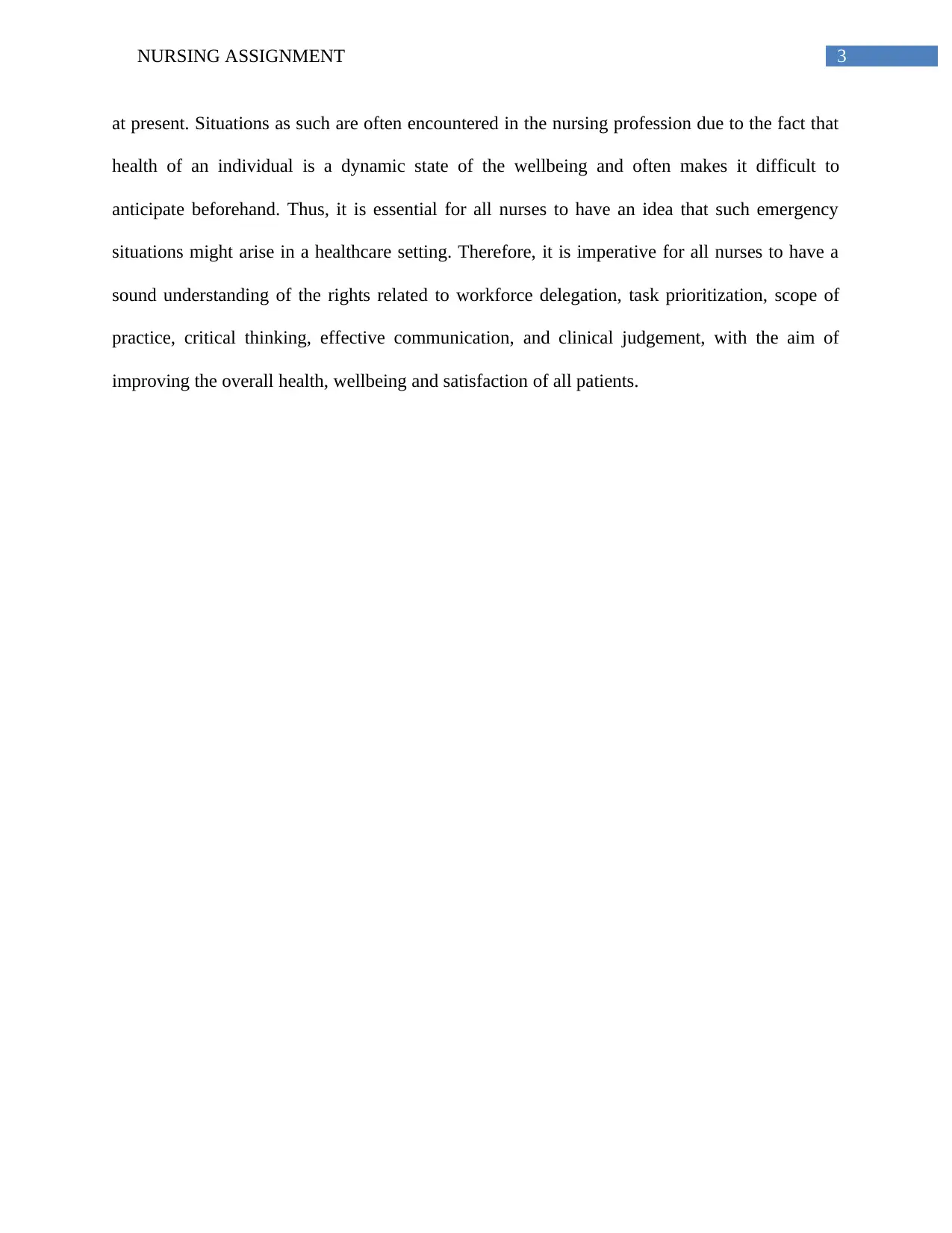
3NURSING ASSIGNMENT
at present. Situations as such are often encountered in the nursing profession due to the fact that
health of an individual is a dynamic state of the wellbeing and often makes it difficult to
anticipate beforehand. Thus, it is essential for all nurses to have an idea that such emergency
situations might arise in a healthcare setting. Therefore, it is imperative for all nurses to have a
sound understanding of the rights related to workforce delegation, task prioritization, scope of
practice, critical thinking, effective communication, and clinical judgement, with the aim of
improving the overall health, wellbeing and satisfaction of all patients.
at present. Situations as such are often encountered in the nursing profession due to the fact that
health of an individual is a dynamic state of the wellbeing and often makes it difficult to
anticipate beforehand. Thus, it is essential for all nurses to have an idea that such emergency
situations might arise in a healthcare setting. Therefore, it is imperative for all nurses to have a
sound understanding of the rights related to workforce delegation, task prioritization, scope of
practice, critical thinking, effective communication, and clinical judgement, with the aim of
improving the overall health, wellbeing and satisfaction of all patients.
Paraphrase This Document
Need a fresh take? Get an instant paraphrase of this document with our AI Paraphraser
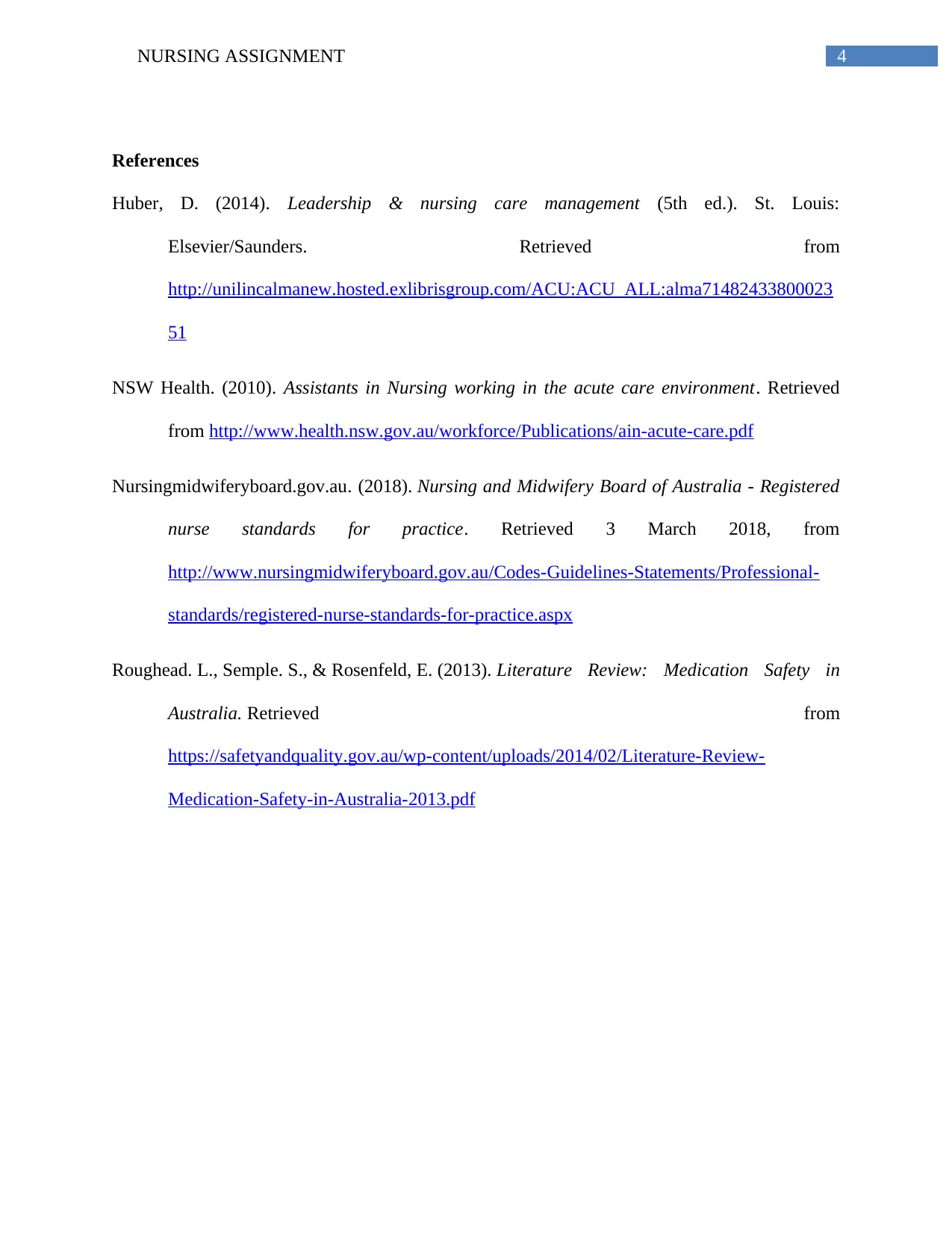
4NURSING ASSIGNMENT
References
Huber, D. (2014). Leadership & nursing care management (5th ed.). St. Louis:
Elsevier/Saunders. Retrieved from
http://unilincalmanew.hosted.exlibrisgroup.com/ACU:ACU_ALL:alma71482433800023
51
NSW Health. (2010). Assistants in Nursing working in the acute care environment. Retrieved
from http://www.health.nsw.gov.au/workforce/Publications/ain-acute-care.pdf
Nursingmidwiferyboard.gov.au. (2018). Nursing and Midwifery Board of Australia - Registered
nurse standards for practice. Retrieved 3 March 2018, from
http://www.nursingmidwiferyboard.gov.au/Codes-Guidelines-Statements/Professional-
standards/registered-nurse-standards-for-practice.aspx
Roughead. L., Semple. S., & Rosenfeld, E. (2013). Literature Review: Medication Safety in
Australia. Retrieved from
https://safetyandquality.gov.au/wp-content/uploads/2014/02/Literature-Review-
Medication-Safety-in-Australia-2013.pdf
References
Huber, D. (2014). Leadership & nursing care management (5th ed.). St. Louis:
Elsevier/Saunders. Retrieved from
http://unilincalmanew.hosted.exlibrisgroup.com/ACU:ACU_ALL:alma71482433800023
51
NSW Health. (2010). Assistants in Nursing working in the acute care environment. Retrieved
from http://www.health.nsw.gov.au/workforce/Publications/ain-acute-care.pdf
Nursingmidwiferyboard.gov.au. (2018). Nursing and Midwifery Board of Australia - Registered
nurse standards for practice. Retrieved 3 March 2018, from
http://www.nursingmidwiferyboard.gov.au/Codes-Guidelines-Statements/Professional-
standards/registered-nurse-standards-for-practice.aspx
Roughead. L., Semple. S., & Rosenfeld, E. (2013). Literature Review: Medication Safety in
Australia. Retrieved from
https://safetyandquality.gov.au/wp-content/uploads/2014/02/Literature-Review-
Medication-Safety-in-Australia-2013.pdf
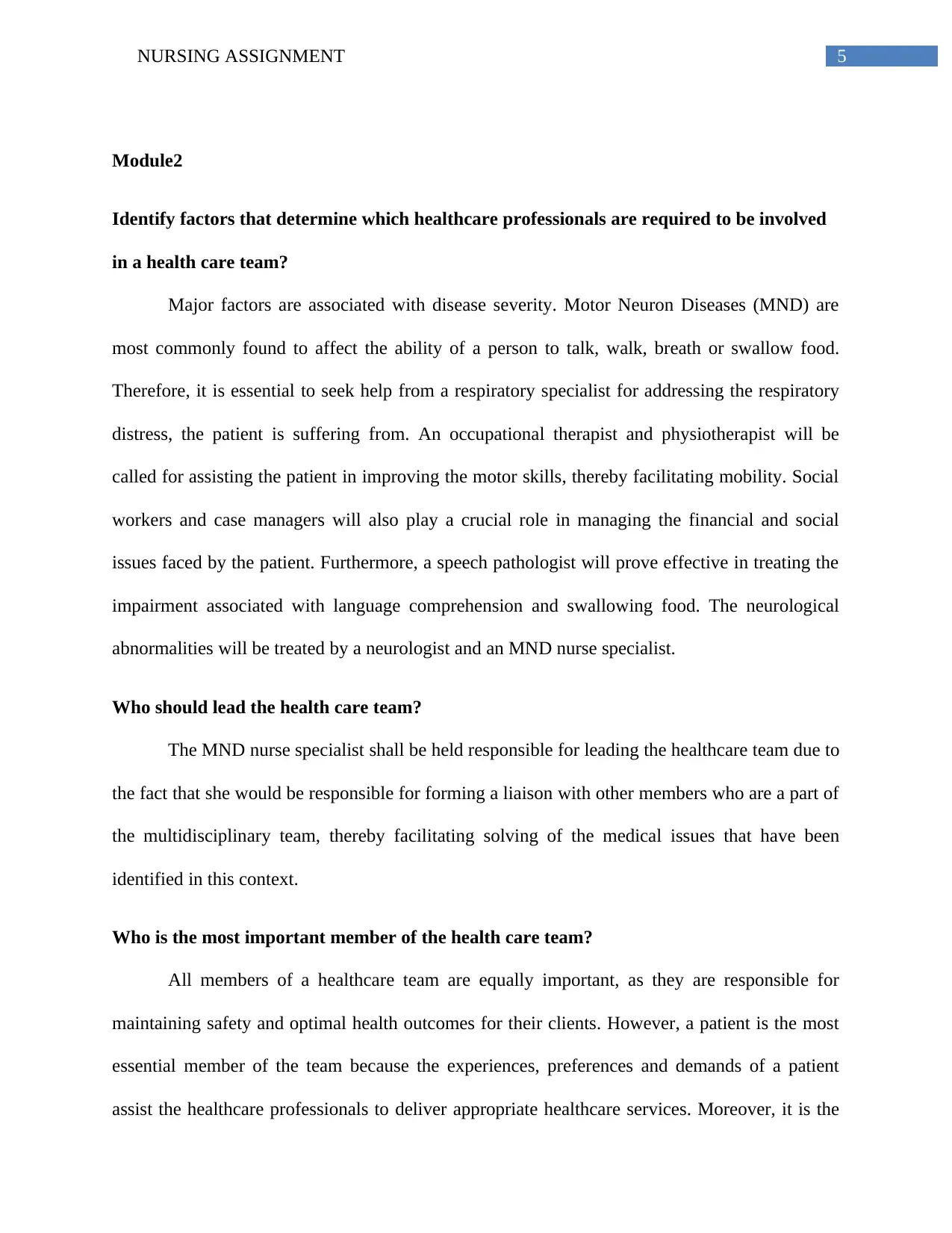
5NURSING ASSIGNMENT
Module2
Identify factors that determine which healthcare professionals are required to be involved
in a health care team?
Major factors are associated with disease severity. Motor Neuron Diseases (MND) are
most commonly found to affect the ability of a person to talk, walk, breath or swallow food.
Therefore, it is essential to seek help from a respiratory specialist for addressing the respiratory
distress, the patient is suffering from. An occupational therapist and physiotherapist will be
called for assisting the patient in improving the motor skills, thereby facilitating mobility. Social
workers and case managers will also play a crucial role in managing the financial and social
issues faced by the patient. Furthermore, a speech pathologist will prove effective in treating the
impairment associated with language comprehension and swallowing food. The neurological
abnormalities will be treated by a neurologist and an MND nurse specialist.
Who should lead the health care team?
The MND nurse specialist shall be held responsible for leading the healthcare team due to
the fact that she would be responsible for forming a liaison with other members who are a part of
the multidisciplinary team, thereby facilitating solving of the medical issues that have been
identified in this context.
Who is the most important member of the health care team?
All members of a healthcare team are equally important, as they are responsible for
maintaining safety and optimal health outcomes for their clients. However, a patient is the most
essential member of the team because the experiences, preferences and demands of a patient
assist the healthcare professionals to deliver appropriate healthcare services. Moreover, it is the
Module2
Identify factors that determine which healthcare professionals are required to be involved
in a health care team?
Major factors are associated with disease severity. Motor Neuron Diseases (MND) are
most commonly found to affect the ability of a person to talk, walk, breath or swallow food.
Therefore, it is essential to seek help from a respiratory specialist for addressing the respiratory
distress, the patient is suffering from. An occupational therapist and physiotherapist will be
called for assisting the patient in improving the motor skills, thereby facilitating mobility. Social
workers and case managers will also play a crucial role in managing the financial and social
issues faced by the patient. Furthermore, a speech pathologist will prove effective in treating the
impairment associated with language comprehension and swallowing food. The neurological
abnormalities will be treated by a neurologist and an MND nurse specialist.
Who should lead the health care team?
The MND nurse specialist shall be held responsible for leading the healthcare team due to
the fact that she would be responsible for forming a liaison with other members who are a part of
the multidisciplinary team, thereby facilitating solving of the medical issues that have been
identified in this context.
Who is the most important member of the health care team?
All members of a healthcare team are equally important, as they are responsible for
maintaining safety and optimal health outcomes for their clients. However, a patient is the most
essential member of the team because the experiences, preferences and demands of a patient
assist the healthcare professionals to deliver appropriate healthcare services. Moreover, it is the
⊘ This is a preview!⊘
Do you want full access?
Subscribe today to unlock all pages.

Trusted by 1+ million students worldwide
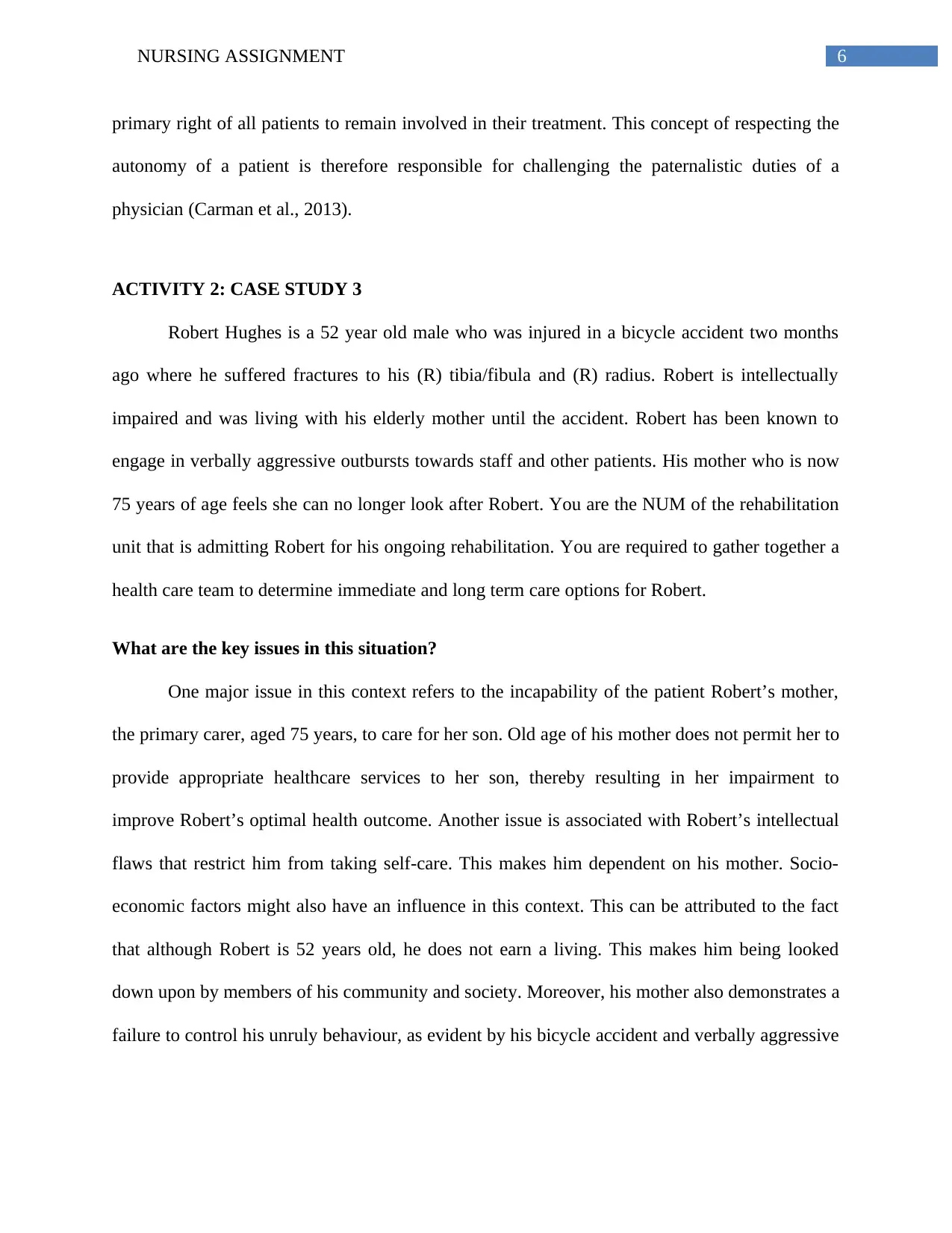
6NURSING ASSIGNMENT
primary right of all patients to remain involved in their treatment. This concept of respecting the
autonomy of a patient is therefore responsible for challenging the paternalistic duties of a
physician (Carman et al., 2013).
ACTIVITY 2: CASE STUDY 3
Robert Hughes is a 52 year old male who was injured in a bicycle accident two months
ago where he suffered fractures to his (R) tibia/fibula and (R) radius. Robert is intellectually
impaired and was living with his elderly mother until the accident. Robert has been known to
engage in verbally aggressive outbursts towards staff and other patients. His mother who is now
75 years of age feels she can no longer look after Robert. You are the NUM of the rehabilitation
unit that is admitting Robert for his ongoing rehabilitation. You are required to gather together a
health care team to determine immediate and long term care options for Robert.
What are the key issues in this situation?
One major issue in this context refers to the incapability of the patient Robert’s mother,
the primary carer, aged 75 years, to care for her son. Old age of his mother does not permit her to
provide appropriate healthcare services to her son, thereby resulting in her impairment to
improve Robert’s optimal health outcome. Another issue is associated with Robert’s intellectual
flaws that restrict him from taking self-care. This makes him dependent on his mother. Socio-
economic factors might also have an influence in this context. This can be attributed to the fact
that although Robert is 52 years old, he does not earn a living. This makes him being looked
down upon by members of his community and society. Moreover, his mother also demonstrates a
failure to control his unruly behaviour, as evident by his bicycle accident and verbally aggressive
primary right of all patients to remain involved in their treatment. This concept of respecting the
autonomy of a patient is therefore responsible for challenging the paternalistic duties of a
physician (Carman et al., 2013).
ACTIVITY 2: CASE STUDY 3
Robert Hughes is a 52 year old male who was injured in a bicycle accident two months
ago where he suffered fractures to his (R) tibia/fibula and (R) radius. Robert is intellectually
impaired and was living with his elderly mother until the accident. Robert has been known to
engage in verbally aggressive outbursts towards staff and other patients. His mother who is now
75 years of age feels she can no longer look after Robert. You are the NUM of the rehabilitation
unit that is admitting Robert for his ongoing rehabilitation. You are required to gather together a
health care team to determine immediate and long term care options for Robert.
What are the key issues in this situation?
One major issue in this context refers to the incapability of the patient Robert’s mother,
the primary carer, aged 75 years, to care for her son. Old age of his mother does not permit her to
provide appropriate healthcare services to her son, thereby resulting in her impairment to
improve Robert’s optimal health outcome. Another issue is associated with Robert’s intellectual
flaws that restrict him from taking self-care. This makes him dependent on his mother. Socio-
economic factors might also have an influence in this context. This can be attributed to the fact
that although Robert is 52 years old, he does not earn a living. This makes him being looked
down upon by members of his community and society. Moreover, his mother also demonstrates a
failure to control his unruly behaviour, as evident by his bicycle accident and verbally aggressive
Paraphrase This Document
Need a fresh take? Get an instant paraphrase of this document with our AI Paraphraser
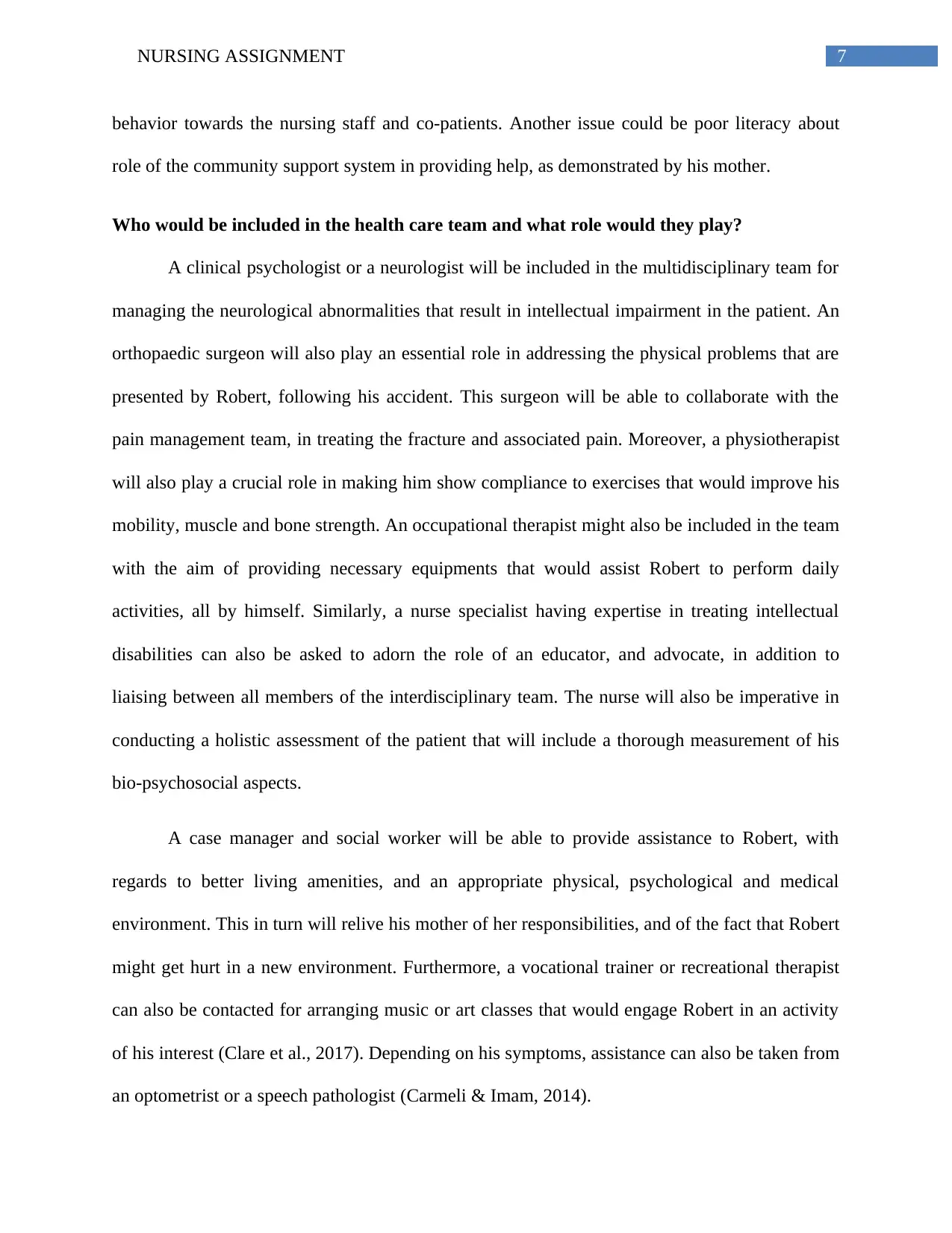
7NURSING ASSIGNMENT
behavior towards the nursing staff and co-patients. Another issue could be poor literacy about
role of the community support system in providing help, as demonstrated by his mother.
Who would be included in the health care team and what role would they play?
A clinical psychologist or a neurologist will be included in the multidisciplinary team for
managing the neurological abnormalities that result in intellectual impairment in the patient. An
orthopaedic surgeon will also play an essential role in addressing the physical problems that are
presented by Robert, following his accident. This surgeon will be able to collaborate with the
pain management team, in treating the fracture and associated pain. Moreover, a physiotherapist
will also play a crucial role in making him show compliance to exercises that would improve his
mobility, muscle and bone strength. An occupational therapist might also be included in the team
with the aim of providing necessary equipments that would assist Robert to perform daily
activities, all by himself. Similarly, a nurse specialist having expertise in treating intellectual
disabilities can also be asked to adorn the role of an educator, and advocate, in addition to
liaising between all members of the interdisciplinary team. The nurse will also be imperative in
conducting a holistic assessment of the patient that will include a thorough measurement of his
bio-psychosocial aspects.
A case manager and social worker will be able to provide assistance to Robert, with
regards to better living amenities, and an appropriate physical, psychological and medical
environment. This in turn will relive his mother of her responsibilities, and of the fact that Robert
might get hurt in a new environment. Furthermore, a vocational trainer or recreational therapist
can also be contacted for arranging music or art classes that would engage Robert in an activity
of his interest (Clare et al., 2017). Depending on his symptoms, assistance can also be taken from
an optometrist or a speech pathologist (Carmeli & Imam, 2014).
behavior towards the nursing staff and co-patients. Another issue could be poor literacy about
role of the community support system in providing help, as demonstrated by his mother.
Who would be included in the health care team and what role would they play?
A clinical psychologist or a neurologist will be included in the multidisciplinary team for
managing the neurological abnormalities that result in intellectual impairment in the patient. An
orthopaedic surgeon will also play an essential role in addressing the physical problems that are
presented by Robert, following his accident. This surgeon will be able to collaborate with the
pain management team, in treating the fracture and associated pain. Moreover, a physiotherapist
will also play a crucial role in making him show compliance to exercises that would improve his
mobility, muscle and bone strength. An occupational therapist might also be included in the team
with the aim of providing necessary equipments that would assist Robert to perform daily
activities, all by himself. Similarly, a nurse specialist having expertise in treating intellectual
disabilities can also be asked to adorn the role of an educator, and advocate, in addition to
liaising between all members of the interdisciplinary team. The nurse will also be imperative in
conducting a holistic assessment of the patient that will include a thorough measurement of his
bio-psychosocial aspects.
A case manager and social worker will be able to provide assistance to Robert, with
regards to better living amenities, and an appropriate physical, psychological and medical
environment. This in turn will relive his mother of her responsibilities, and of the fact that Robert
might get hurt in a new environment. Furthermore, a vocational trainer or recreational therapist
can also be contacted for arranging music or art classes that would engage Robert in an activity
of his interest (Clare et al., 2017). Depending on his symptoms, assistance can also be taken from
an optometrist or a speech pathologist (Carmeli & Imam, 2014).
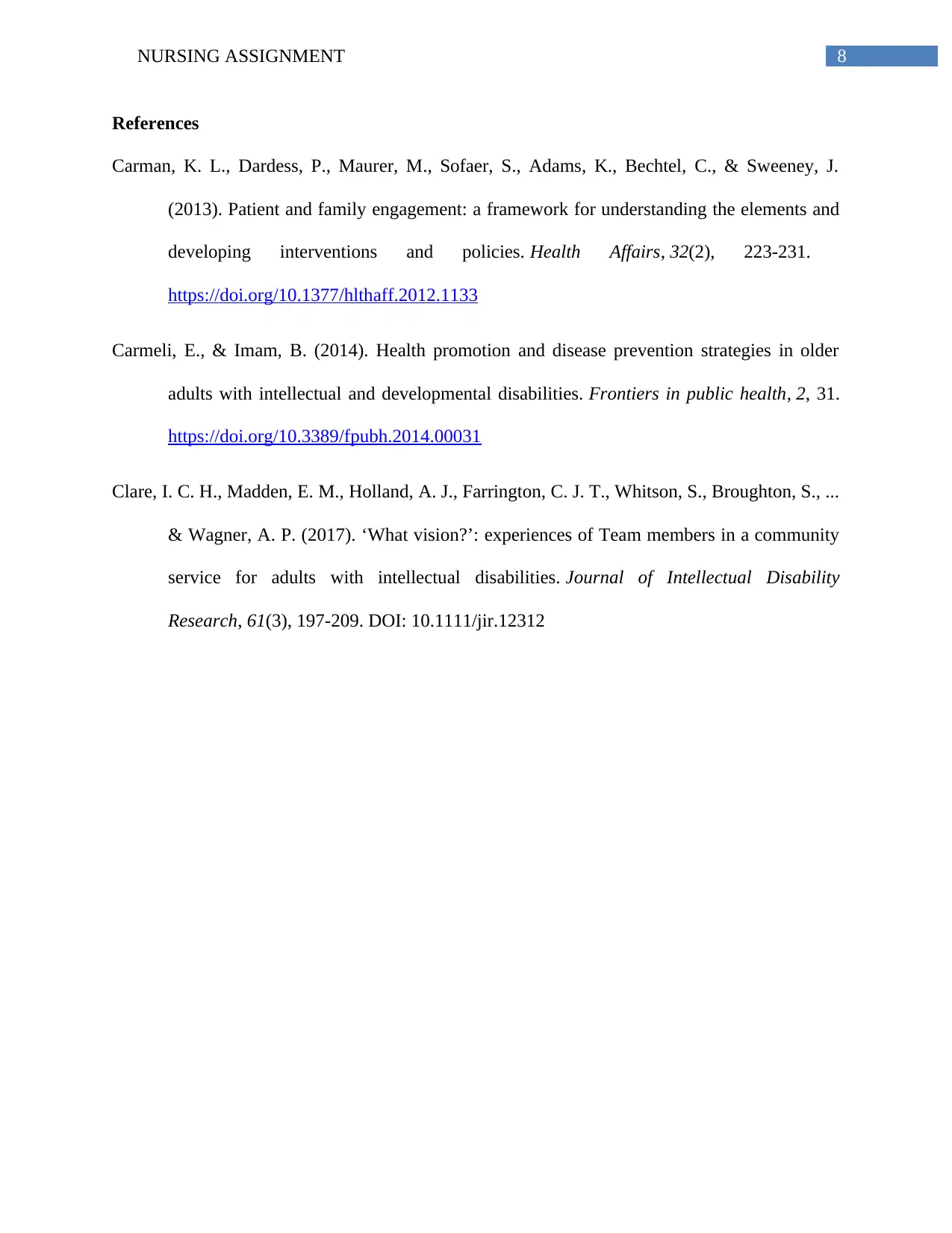
8NURSING ASSIGNMENT
References
Carman, K. L., Dardess, P., Maurer, M., Sofaer, S., Adams, K., Bechtel, C., & Sweeney, J.
(2013). Patient and family engagement: a framework for understanding the elements and
developing interventions and policies. Health Affairs, 32(2), 223-231.
https://doi.org/10.1377/hlthaff.2012.1133
Carmeli, E., & Imam, B. (2014). Health promotion and disease prevention strategies in older
adults with intellectual and developmental disabilities. Frontiers in public health, 2, 31.
https://doi.org/10.3389/fpubh.2014.00031
Clare, I. C. H., Madden, E. M., Holland, A. J., Farrington, C. J. T., Whitson, S., Broughton, S., ...
& Wagner, A. P. (2017). ‘What vision?’: experiences of Team members in a community
service for adults with intellectual disabilities. Journal of Intellectual Disability
Research, 61(3), 197-209. DOI: 10.1111/jir.12312
References
Carman, K. L., Dardess, P., Maurer, M., Sofaer, S., Adams, K., Bechtel, C., & Sweeney, J.
(2013). Patient and family engagement: a framework for understanding the elements and
developing interventions and policies. Health Affairs, 32(2), 223-231.
https://doi.org/10.1377/hlthaff.2012.1133
Carmeli, E., & Imam, B. (2014). Health promotion and disease prevention strategies in older
adults with intellectual and developmental disabilities. Frontiers in public health, 2, 31.
https://doi.org/10.3389/fpubh.2014.00031
Clare, I. C. H., Madden, E. M., Holland, A. J., Farrington, C. J. T., Whitson, S., Broughton, S., ...
& Wagner, A. P. (2017). ‘What vision?’: experiences of Team members in a community
service for adults with intellectual disabilities. Journal of Intellectual Disability
Research, 61(3), 197-209. DOI: 10.1111/jir.12312
⊘ This is a preview!⊘
Do you want full access?
Subscribe today to unlock all pages.

Trusted by 1+ million students worldwide
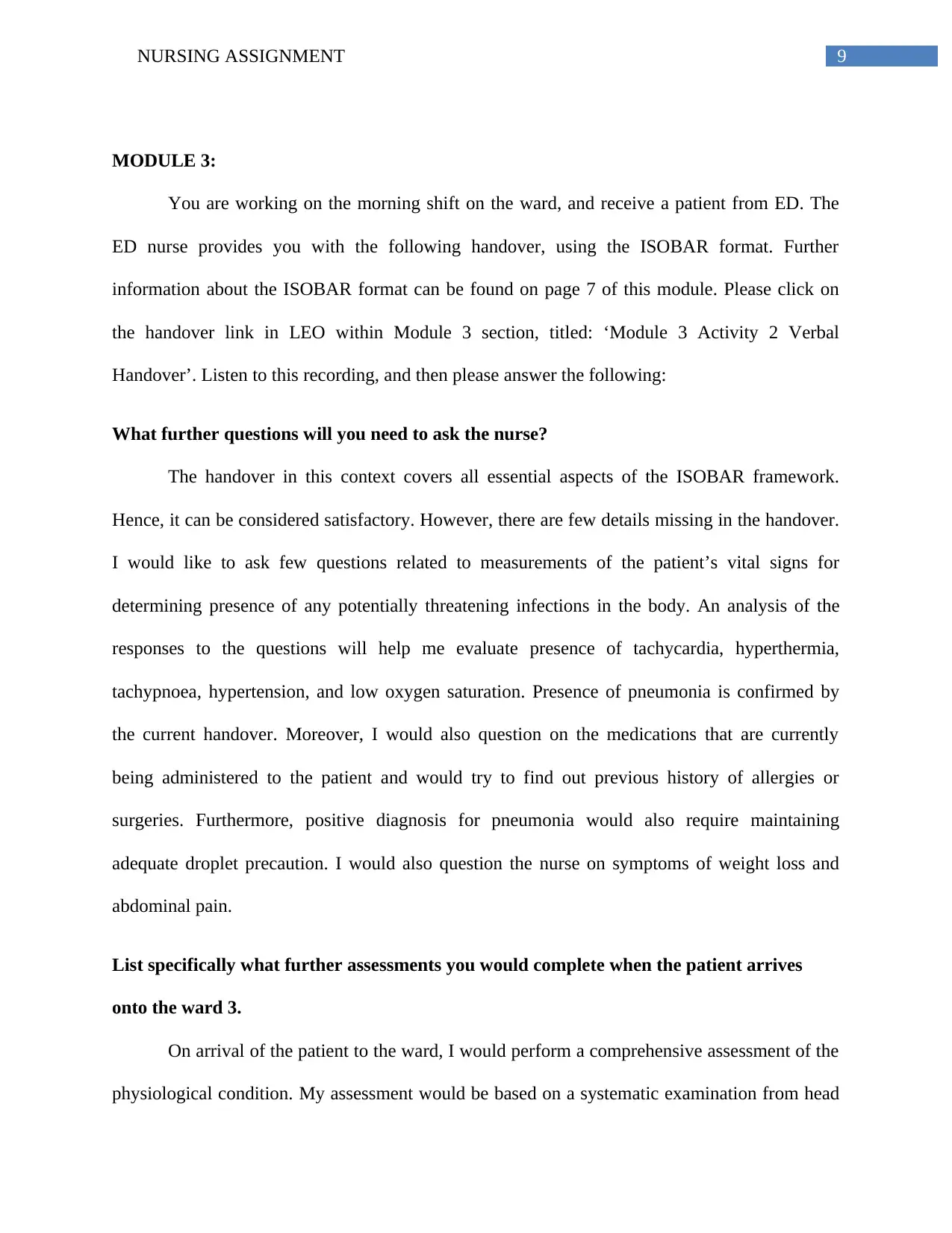
9NURSING ASSIGNMENT
MODULE 3:
You are working on the morning shift on the ward, and receive a patient from ED. The
ED nurse provides you with the following handover, using the ISOBAR format. Further
information about the ISOBAR format can be found on page 7 of this module. Please click on
the handover link in LEO within Module 3 section, titled: ‘Module 3 Activity 2 Verbal
Handover’. Listen to this recording, and then please answer the following:
What further questions will you need to ask the nurse?
The handover in this context covers all essential aspects of the ISOBAR framework.
Hence, it can be considered satisfactory. However, there are few details missing in the handover.
I would like to ask few questions related to measurements of the patient’s vital signs for
determining presence of any potentially threatening infections in the body. An analysis of the
responses to the questions will help me evaluate presence of tachycardia, hyperthermia,
tachypnoea, hypertension, and low oxygen saturation. Presence of pneumonia is confirmed by
the current handover. Moreover, I would also question on the medications that are currently
being administered to the patient and would try to find out previous history of allergies or
surgeries. Furthermore, positive diagnosis for pneumonia would also require maintaining
adequate droplet precaution. I would also question the nurse on symptoms of weight loss and
abdominal pain.
List specifically what further assessments you would complete when the patient arrives
onto the ward 3.
On arrival of the patient to the ward, I would perform a comprehensive assessment of the
physiological condition. My assessment would be based on a systematic examination from head
MODULE 3:
You are working on the morning shift on the ward, and receive a patient from ED. The
ED nurse provides you with the following handover, using the ISOBAR format. Further
information about the ISOBAR format can be found on page 7 of this module. Please click on
the handover link in LEO within Module 3 section, titled: ‘Module 3 Activity 2 Verbal
Handover’. Listen to this recording, and then please answer the following:
What further questions will you need to ask the nurse?
The handover in this context covers all essential aspects of the ISOBAR framework.
Hence, it can be considered satisfactory. However, there are few details missing in the handover.
I would like to ask few questions related to measurements of the patient’s vital signs for
determining presence of any potentially threatening infections in the body. An analysis of the
responses to the questions will help me evaluate presence of tachycardia, hyperthermia,
tachypnoea, hypertension, and low oxygen saturation. Presence of pneumonia is confirmed by
the current handover. Moreover, I would also question on the medications that are currently
being administered to the patient and would try to find out previous history of allergies or
surgeries. Furthermore, positive diagnosis for pneumonia would also require maintaining
adequate droplet precaution. I would also question the nurse on symptoms of weight loss and
abdominal pain.
List specifically what further assessments you would complete when the patient arrives
onto the ward 3.
On arrival of the patient to the ward, I would perform a comprehensive assessment of the
physiological condition. My assessment would be based on a systematic examination from head
Paraphrase This Document
Need a fresh take? Get an instant paraphrase of this document with our AI Paraphraser
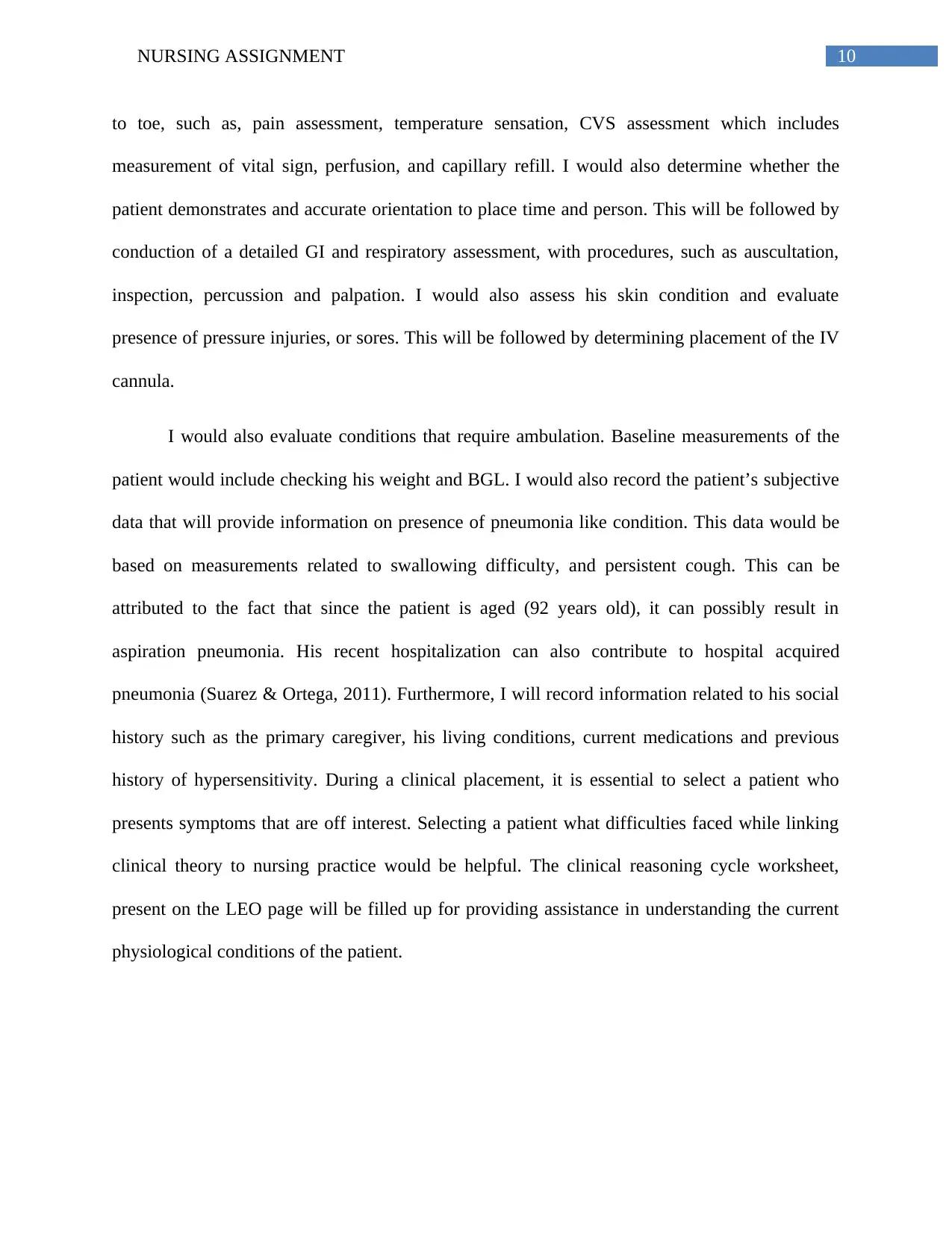
10NURSING ASSIGNMENT
to toe, such as, pain assessment, temperature sensation, CVS assessment which includes
measurement of vital sign, perfusion, and capillary refill. I would also determine whether the
patient demonstrates and accurate orientation to place time and person. This will be followed by
conduction of a detailed GI and respiratory assessment, with procedures, such as auscultation,
inspection, percussion and palpation. I would also assess his skin condition and evaluate
presence of pressure injuries, or sores. This will be followed by determining placement of the IV
cannula.
I would also evaluate conditions that require ambulation. Baseline measurements of the
patient would include checking his weight and BGL. I would also record the patient’s subjective
data that will provide information on presence of pneumonia like condition. This data would be
based on measurements related to swallowing difficulty, and persistent cough. This can be
attributed to the fact that since the patient is aged (92 years old), it can possibly result in
aspiration pneumonia. His recent hospitalization can also contribute to hospital acquired
pneumonia (Suarez & Ortega, 2011). Furthermore, I will record information related to his social
history such as the primary caregiver, his living conditions, current medications and previous
history of hypersensitivity. During a clinical placement, it is essential to select a patient who
presents symptoms that are off interest. Selecting a patient what difficulties faced while linking
clinical theory to nursing practice would be helpful. The clinical reasoning cycle worksheet,
present on the LEO page will be filled up for providing assistance in understanding the current
physiological conditions of the patient.
to toe, such as, pain assessment, temperature sensation, CVS assessment which includes
measurement of vital sign, perfusion, and capillary refill. I would also determine whether the
patient demonstrates and accurate orientation to place time and person. This will be followed by
conduction of a detailed GI and respiratory assessment, with procedures, such as auscultation,
inspection, percussion and palpation. I would also assess his skin condition and evaluate
presence of pressure injuries, or sores. This will be followed by determining placement of the IV
cannula.
I would also evaluate conditions that require ambulation. Baseline measurements of the
patient would include checking his weight and BGL. I would also record the patient’s subjective
data that will provide information on presence of pneumonia like condition. This data would be
based on measurements related to swallowing difficulty, and persistent cough. This can be
attributed to the fact that since the patient is aged (92 years old), it can possibly result in
aspiration pneumonia. His recent hospitalization can also contribute to hospital acquired
pneumonia (Suarez & Ortega, 2011). Furthermore, I will record information related to his social
history such as the primary caregiver, his living conditions, current medications and previous
history of hypersensitivity. During a clinical placement, it is essential to select a patient who
presents symptoms that are off interest. Selecting a patient what difficulties faced while linking
clinical theory to nursing practice would be helpful. The clinical reasoning cycle worksheet,
present on the LEO page will be filled up for providing assistance in understanding the current
physiological conditions of the patient.
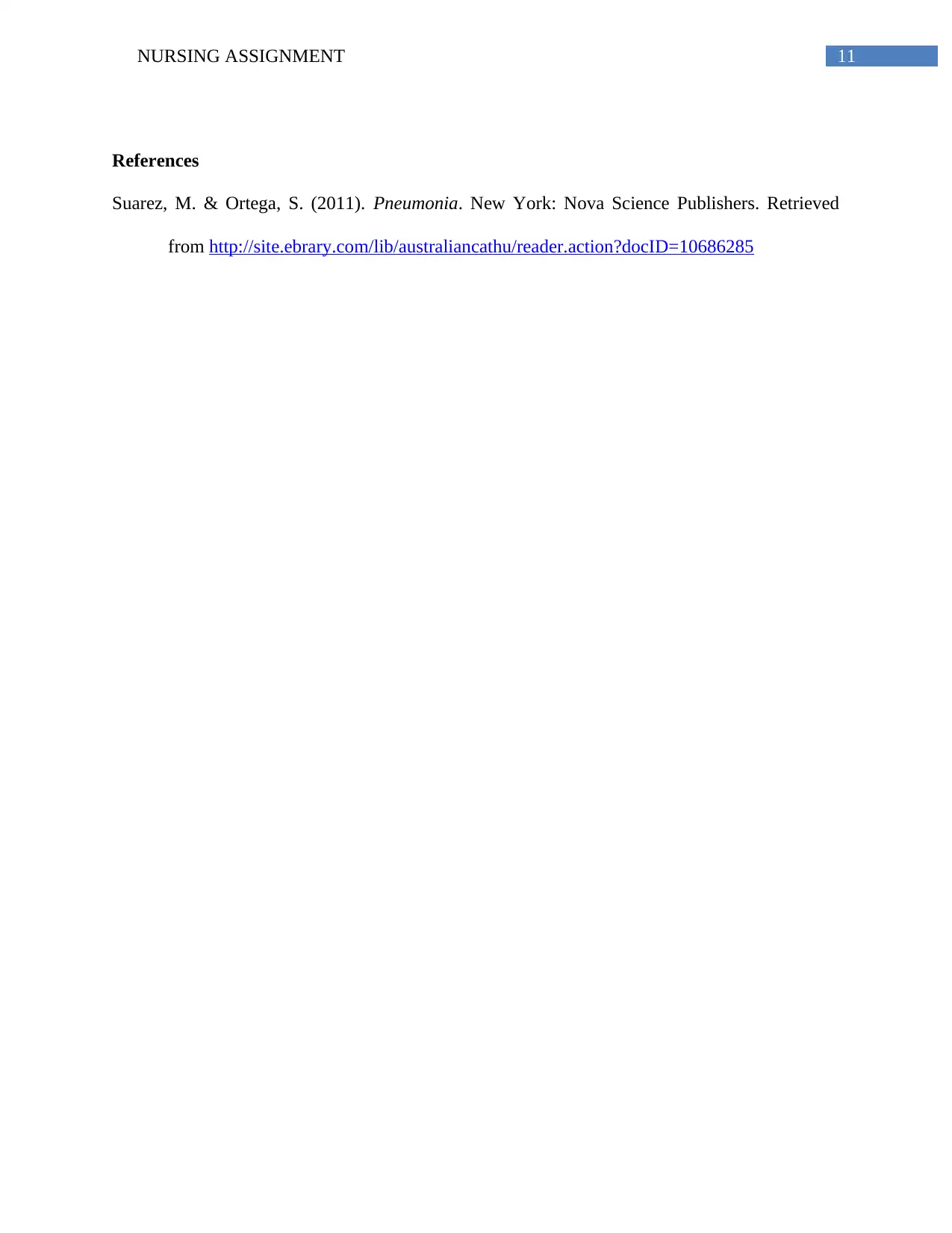
11NURSING ASSIGNMENT
References
Suarez, M. & Ortega, S. (2011). Pneumonia. New York: Nova Science Publishers. Retrieved
from http://site.ebrary.com/lib/australiancathu/reader.action?docID=10686285
References
Suarez, M. & Ortega, S. (2011). Pneumonia. New York: Nova Science Publishers. Retrieved
from http://site.ebrary.com/lib/australiancathu/reader.action?docID=10686285
⊘ This is a preview!⊘
Do you want full access?
Subscribe today to unlock all pages.

Trusted by 1+ million students worldwide
1 out of 21
Related Documents
Your All-in-One AI-Powered Toolkit for Academic Success.
+13062052269
info@desklib.com
Available 24*7 on WhatsApp / Email
![[object Object]](/_next/static/media/star-bottom.7253800d.svg)
Unlock your academic potential
Copyright © 2020–2025 A2Z Services. All Rights Reserved. Developed and managed by ZUCOL.





